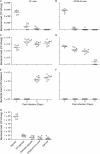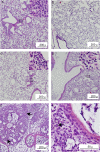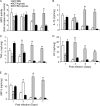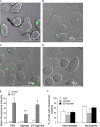Pseudomonas aeruginosa alginate promotes Burkholderia cenocepacia persistence in cystic fibrosis transmembrane conductance regulator knockout mice
- PMID: 20048042
- PMCID: PMC2825924
- DOI: 10.1128/IAI.01192-09
Pseudomonas aeruginosa alginate promotes Burkholderia cenocepacia persistence in cystic fibrosis transmembrane conductance regulator knockout mice
Abstract
Pseudomonas aeruginosa, a major respiratory pathogen in cystic fibrosis (CF) patients, facilitates infection by other opportunistic pathogens. Burkholderia cenocepacia, which normally infects adolescent patients, encounters alginate elaborated by mucoid P. aeruginosa. To determine whether P. aeruginosa alginate facilitates B. cenocepacia infection in mice, cystic fibrosis transmembrane conductance regulator knockout mice were infected with B. cenocepacia strain BC7 suspended in either phosphate-buffered saline (BC7/PBS) or P. aeruginosa alginate (BC7/alginate), and the pulmonary bacterial load and inflammation were monitored. Mice infected with BC7/PBS cleared all of the bacteria within 3 days, and inflammation was resolved by day 5. In contrast, mice infected with BC7/alginate showed persistence of bacteria and increased cytokine levels for up to 7 days. Histological examination of the lungs indicated that there was moderate to severe inflammation and pneumonic consolidation in isolated areas at 5 and 7 days postinfection in the BC7/alginate group. Further, alginate decreased phagocytosis of B. cenocepacia by professional phagocytes both in vivo and in vitro. P. aeruginosa alginate also reduced the proinflammatory responses of CF airway epithelial cells and alveolar macrophages to B. cenocepacia infection. The observed effects are specific to P. aeruginosa alginate, because enzymatically degraded alginate or other polyuronic acids did not facilitate bacterial persistence. These observations suggest that P. aeruginosa alginate may facilitate B. cenocepacia infection by interfering with host innate defense mechanisms.
Figures







Similar articles
-
Cable pili and the associated 22 kDa adhesin contribute to Burkholderia cenocepacia persistence in vivo.PLoS One. 2011;6(7):e22435. doi: 10.1371/journal.pone.0022435. Epub 2011 Jul 21. PLoS One. 2011. PMID: 21811611 Free PMC article.
-
Bacterial cis-2-unsaturated fatty acids found in the cystic fibrosis airway modulate virulence and persistence of Pseudomonas aeruginosa.ISME J. 2012 May;6(5):939-50. doi: 10.1038/ismej.2011.167. Epub 2011 Dec 1. ISME J. 2012. PMID: 22134647 Free PMC article.
-
Burkholderia cenocepacia-induced delay of acidification and phagolysosomal fusion in cystic fibrosis transmembrane conductance regulator (CFTR)-defective macrophages.Microbiology (Reading). 2008 Dec;154(Pt 12):3825-3834. doi: 10.1099/mic.0.2008/023200-0. Microbiology (Reading). 2008. PMID: 19047750
-
Alginate production by the mucoid Pseudomonas aeruginosa associated with cystic fibrosis.Microbiol Sci. 1987 Oct;4(10):296-9. Microbiol Sci. 1987. PMID: 3155272 Review.
-
Lung infection with alginate-producing, mucoid Pseudomonas aeruginosa in cystic fibrosis.APMIS Suppl. 1992;28:1-79. APMIS Suppl. 1992. PMID: 1449848 Review.
Cited by
-
Toward Dual-Target Glycomimetics against Two Bacterial Lectins to Fight Pseudomonas aeruginosa-Burkholderia cenocepacia Infections: A Biophysical Study.J Med Chem. 2025 May 8;68(9):9681-9693. doi: 10.1021/acs.jmedchem.5c00405. Epub 2025 Apr 25. J Med Chem. 2025. PMID: 40279549 Free PMC article.
-
Pseudomonas aeruginosa modulates alginate biosynthesis and type VI secretion system in two critically ill COVID-19 patients.Cell Biosci. 2022 Feb 9;12(1):14. doi: 10.1186/s13578-022-00748-z. Cell Biosci. 2022. PMID: 35139898 Free PMC article.
-
An Organ System-Based Synopsis of Pseudomonas aeruginosa Virulence.Virulence. 2021 Dec;12(1):1469-1507. doi: 10.1080/21505594.2021.1926408. Virulence. 2021. PMID: 34180343 Free PMC article. Review.
-
Cystic Fibrosis: Microbiology and Host Response.Pediatr Clin North Am. 2016 Aug;63(4):617-36. doi: 10.1016/j.pcl.2016.04.003. Pediatr Clin North Am. 2016. PMID: 27469179 Free PMC article. Review.
-
Pseudomonas aeruginosa suppresses interferon response to rhinovirus infection in cystic fibrosis but not in normal bronchial epithelial cells.Infect Immun. 2011 Oct;79(10):4131-45. doi: 10.1128/IAI.05120-11. Epub 2011 Aug 8. Infect Immun. 2011. PMID: 21825067 Free PMC article.
References
-
- Cabral, D. A., B. A. Loh, and D. P. Speert. 1987. Mucoid Pseudomonas aeruginosa resists nonopsonic phagocytosis by human neutrophils and macrophages. Pediatr. Res. 22:429-431. - PubMed
-
- Cesaretti, M., E. Luppi, F. Maccari, and N. Volpi. 2003. A 96-well assay for uronic acid carbazole reaction. Carbohydr. Polym. 54:59-61.
Publication types
MeSH terms
Substances
Grants and funding
LinkOut - more resources
Full Text Sources
Medical
Molecular Biology Databases

